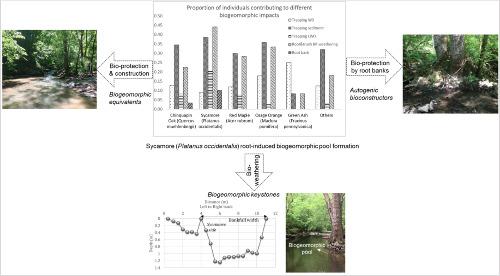当前位置:
X-MOL 学术
›
Earth Surf.Process. Land.
›
论文详情
Our official English website, www.x-mol.net, welcomes your feedback! (Note: you will need to create a separate account there.)
Biogeomorphic keystones and equivalents: Examples from a bedrock stream
Earth Surface Processes and Landforms ( IF 3.3 ) Pub Date : 2020-03-24 , DOI: 10.1002/esp.4853 Tasnuba Jerin 1 , Jonathan Phillips 1
Earth Surface Processes and Landforms ( IF 3.3 ) Pub Date : 2020-03-24 , DOI: 10.1002/esp.4853 Tasnuba Jerin 1 , Jonathan Phillips 1
Affiliation

|
Biogeomorphic keystone species profoundly impact landscapes, such that their introduction or removal would cause fundamental changes in geomorphic systems. This paper explores the concept of biogeomorphic keystone species by examining the general vs. species‐specific biogeomorphic impacts (BGIs) of trees on a limestone bedrock‐controlled stream, Shawnee Run, in central Kentucky. Field investigation identified three strong BGIs: (i) biogeomorphic pool formation via bioweathering; (ii) root bank‐associated bioprotection; and (iii) avulsion‐originated island development linked to bioprotection. This research evaluates these impacts in the context of keystone or other biogeomorphic roles. A field survey was conducted on nine stream reaches, each consisting of 10–12 hydraulic units of riffle, pool, and run. Results suggest that American sycamore (Platanus occidentalis) plays a keystone role by promoting the development of ~42% of pools in the study area. While geomorphic pools are formed by fluvial process–form linkages, these biogeomorphic pools are developed by sycamore root‐induced channel bed bioweathering. Only American sycamore and chinquapin oak (Quercus muehlenbergii) exhibited root‐bank development amongst 15 different species identified – and thus play a vital role in bank bioprotection. Lastly, trees can promote avulsion‐originated island formation by creating erosion‐resistant bioprotective patches. Mature trees (in terms of size), particularly large American sycamore and chinquapin oak, dominate Shawnee Run islands with a mean diameter at breast height (DBH) > 40 cm. However, other trees can provide comparable bioprotection, particularly at mature stages. Because its absence would result in fundamentally different stream morphology, sycamore can be considered a biogeomorphic keystone species in Shawnee Run. © 2020 John Wiley & Sons, Ltd.
中文翻译:

生物地貌基石和等同物:基岩流的例子
生物地貌基石物种对景观产生深远的影响,因此将其引入或移除会引起地貌系统的根本变化。本文通过研究肯塔基州中部石灰岩基岩控制流Shawnee Run上树木的一般与物种特有的生物地貌影响(BGI),探索了生物地貌基石物种的概念。现场调查确定了三个强大的BGI:(i)生物地貌库通过生物风化形成;(ii)与根库相关的生物保护;(iii)与生物保护有关的以破坏为基础的岛屿发展。这项研究在基石或其他生物地貌角色的背景下评估了这些影响。在九个河段进行了现场调查,每个河段由浅滩,水池和河段的10–12个液压单元组成。结果表明,美国梧桐(Pattanus occidentalis)通过促进研究区域内约42%的水池发育而发挥了关键作用。虽然地貌库是通过河流过程与形式的联系而形成的,但这些生物地貌库是由美国梧桐根诱导的河床生物风化作用开发的。只有美国梧桐和欧洲栗(Quercus muehlenbergii)表现出根系确定了15个不同物种之间的发育-因此在银行生物保护中起着至关重要的作用。最后,树木可以通过创建抗侵蚀的生物保护斑块来促进起源于侵蚀的岛屿形成。成熟的树木(就大小而言),尤其是大的美国梧桐和欧洲栗树的橡树,在肖尼·朗(Shawnee Run)岛上占主导地位,其平均胸径(DBH)> 40 cm。但是,其他树木可以提供相当的生物保护,尤其是在成熟阶段。由于它的缺失将导致根本不同的水流形态,因此无花果可以被视为Shawnee Run中的生物地貌基石种。©2020 John Wiley&Sons,Ltd.
更新日期:2020-03-24
中文翻译:

生物地貌基石和等同物:基岩流的例子
生物地貌基石物种对景观产生深远的影响,因此将其引入或移除会引起地貌系统的根本变化。本文通过研究肯塔基州中部石灰岩基岩控制流Shawnee Run上树木的一般与物种特有的生物地貌影响(BGI),探索了生物地貌基石物种的概念。现场调查确定了三个强大的BGI:(i)生物地貌库通过生物风化形成;(ii)与根库相关的生物保护;(iii)与生物保护有关的以破坏为基础的岛屿发展。这项研究在基石或其他生物地貌角色的背景下评估了这些影响。在九个河段进行了现场调查,每个河段由浅滩,水池和河段的10–12个液压单元组成。结果表明,美国梧桐(Pattanus occidentalis)通过促进研究区域内约42%的水池发育而发挥了关键作用。虽然地貌库是通过河流过程与形式的联系而形成的,但这些生物地貌库是由美国梧桐根诱导的河床生物风化作用开发的。只有美国梧桐和欧洲栗(Quercus muehlenbergii)表现出根系确定了15个不同物种之间的发育-因此在银行生物保护中起着至关重要的作用。最后,树木可以通过创建抗侵蚀的生物保护斑块来促进起源于侵蚀的岛屿形成。成熟的树木(就大小而言),尤其是大的美国梧桐和欧洲栗树的橡树,在肖尼·朗(Shawnee Run)岛上占主导地位,其平均胸径(DBH)> 40 cm。但是,其他树木可以提供相当的生物保护,尤其是在成熟阶段。由于它的缺失将导致根本不同的水流形态,因此无花果可以被视为Shawnee Run中的生物地貌基石种。©2020 John Wiley&Sons,Ltd.


























 京公网安备 11010802027423号
京公网安备 11010802027423号